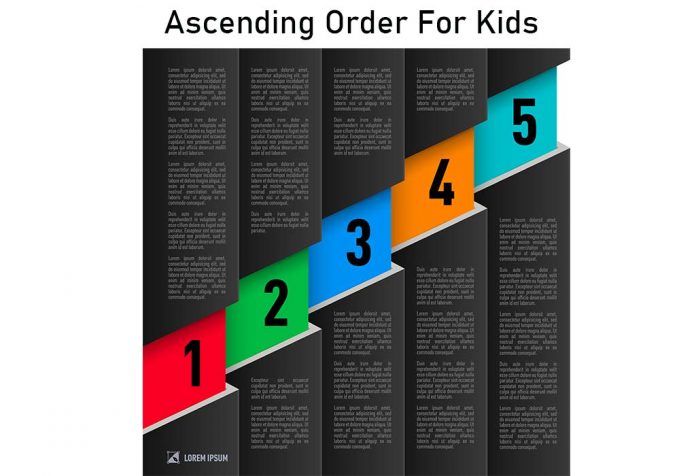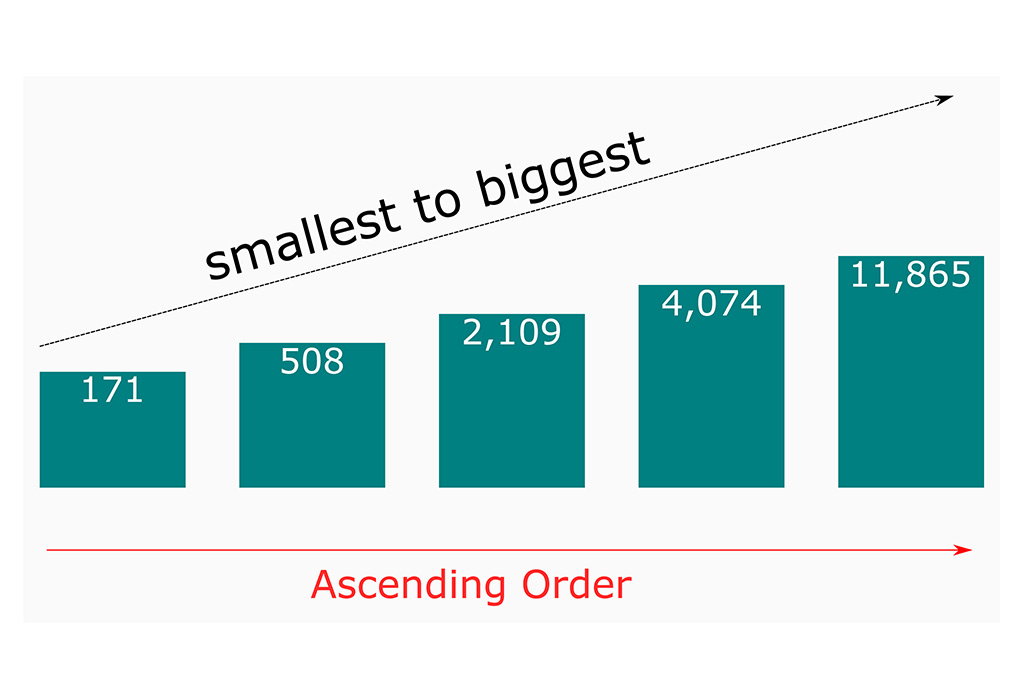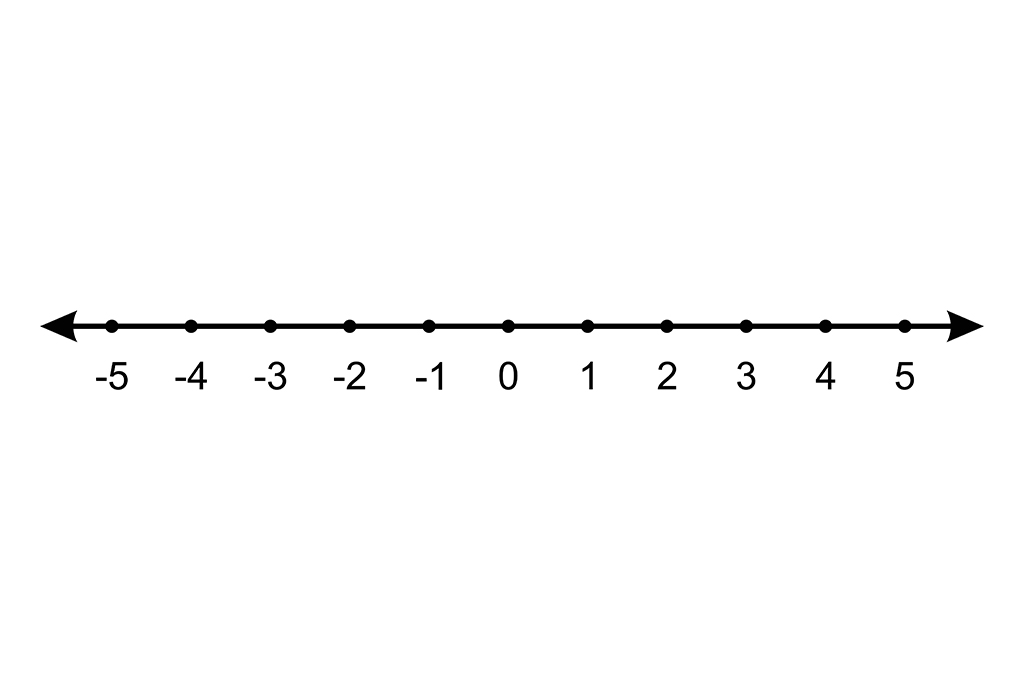The children are taught to arrange things in ascending or descending order to help them develop a better logical and practical thinking approach towards things in general. Ascending order for preschoolers is a concept of arranging the numbers or alphabet, which is helpful for the kids in a number of ways. This also helps to strengthen their mathematical base.
In this article, we have talked about what is ascending order, how to arrange the numbers and alphabets in ascending order and some examples of the same. Let’s take a look at ascending order for classes 1, 2 and 3.
What Is Ascending Order?
Ascending order means arranging the numbers from smallest to largest. In simple words, it means arranging the numbers in increasing order. The word ascending means going up; therefore, ascending order can also be understood as an arrangement of numbers going up.
To make it easy for children to understand this, ask them to think that they are climbing the staircase. The first stair is number one, and the second stair is number 2 and so on. So, as the child climbs the steps, they are climbing up or ascending.
Let’s take a look at the symbol of ascending order and its examples.
What Is The Symbol And Example Of Ascending Order?
1. Symbol Of Ascending Order
We arrange the given set of numbers in ascending order by putting commas “,” or using the less than symbol “<”. This explains that the number on the left has a smaller value as compared to the number on the right side of the symbol.
2. Examples Of Ascending Order
- The given list of numbers is 90, 3, 47, 150, 1743, and 570.
- To arrange the given numbers in ascending, we first need to look for the smallest number. Here the smallest number is 3.
- Next, we need to look for the biggest number. Here the biggest number is 1743.
- Then we have to look for the numbers in between these two numbers and arrange them from smallest or biggest.
- The final result that we will get for the ascending order for the given list of numbers is 3, 47, 90, 150, 570, and 1743.
Some more examples of ascending order are:
- 1 < 2 < 3 < 4 < 5
- 10 < 12 < 14 < 16
- 43 < 53 < 73 < 93 < 103
- 100, 1000, 10000, 100000
- -10 < -9 < -8 < -7 < -6
Learning Ascending Order On Number Line
The number line is a great way to learn about ascending order. This way, your child will be easily able to understand how to arrange the numbers on ascending. Let’s take a look at it.
In the above number lines, numbers from -5 to 5 are arranged in ascending order. It represents that the numbers on the left-hand side of 0 are smaller than the numbers on the right-hand side of 0 on the number line. As we read the number line and go from left to right, the value of the numbers increases.
How To Arrange Numbers And Alphabets In Ascending Order?
Now that your child knows what ascending order is and to represent ascending order using the symbol, let’s take a look at how to arrange numbers and alphabets in ascending order.
1. Integers
Integers are numbers that can be positive, negative, or zero. Let’s understand the ascending order of integers and how to arrange them.
- Compare the given number of digits in each number.
- The number with fewer digits is the smallest number.
- The number with the highest digits is the biggest.
- If the number of digits is the same in numbers, then compare the left-most digits of the numbers.
- Arrange all the numbers from smallest to largest.
- Example: 2 < 6 < 12 < 24 < 100
2. Negative Numbers
Negative numbers are the ones that have a minus sign as a prefix. Negative numbers can be integers, decimals, or fractions. Let’s take a look at the ascending order of negative numbers.
1). If the biggest number has a negative sign, then it becomes the smallest valued number.
- Example: 2 is greater than 1, but – 2 is smaller than 1. -2<1
2). Also, a two-digit negative number is smaller than a single-digit negative number.
- Example: -45 is smaller than –7 or –45 <-7
3. Fractions
Fractions are numerical quantities that are not the whole number. Let’s take a look at ascending order in fractions.
1) Technique 1
- Convert fractions into decimal numbers.
- Arrange decimal numbers in increasing order.
- Convert back the decimal values into factions.
2) Technique 2
- Find the L.C.M of the denominators.
- Divide the L.C.M value by the denominator of the given fraction.
- Multiply both the numerator and denominator of the fraction with the resultant value above.
- Compare the above like fractions.
- Compare the numerator values of like fractions.
- Arrange the fractions in increasing order with their respective fractions given in the question.
4. Decimals
Decimals are fractions whose denominator is a power of ten, and their numerator is expressed by a value placed to the right of a decimal point. Let’s take a look at decimal ascending order.
To arrange decimals in ascending order, check which decimal has the least whole number part and then arrange the decimals with increasing order of whole number part. In case the whole number part is the same for decimals, then arrange the decimals according to the decimal part after the decimal point, in ascending order.
- Example: 1.2 < 2.4 < 3.5 < 3.8 < 4.3
5. Alphabets
Finally, let’s take a look at ascending order of the alphabet.
a < b < c < d < e < f < g < h < i < j < k < l < m < n < o < p < q < r < s < t < u < v < w < x < y < z
What Is The Difference Between Ascending And Descending Order?
| Ascending Order | Descending Order |
| Numbers are arranged in increasing order of value. | Numbers are arranged in decreasing order of value. |
| The smallest number is at the extreme left, and the largest is at the extreme right. | The largest number is at the extreme left, and the smallest number is at the extreme right. |
| The symbol is “<”. | The symbol is “>”. |
| Example: 1 < 4 < 6 < 8. | Example: 8 > 6 > 4 > 1. |
Solved Example On Ascending Order
Let’s take a look at the example of how to sort in ascending order of the given set of arrangements.
1. Arrange 20, 54, -35, 56, and 8 in ascending order.
Answer: -35< 8 < 240< 54 < 56
2. Write the missing numbers in ascending order? 2, _, 6, _, 10
Answer: 2, 4, 6, 8, 10
3. Arrange the integers −3, 0, −6, 6, 4, −1 in Ascending Order.
Answer: -6, -3, -1, 0, 4, 6
4. Write 23 to 26 in ascending order.
Answer: 23 < 24 < 25 < 26
5. Arrange in ascending order – 0.83, 0.5, 0.4, 0.5
Answer: 0.4 < 0.5 < 0.6 < 0.83
We hope this article helps your child to understand ascending order with the help of the examples shared above. If you have any doubts related to the topic, you can share them in the comments below.
Also Read:
Descending Order for Children
Teaching Even Numbers to Kids with Examples
Easy Ways to Teach Your Child Number Sentence











